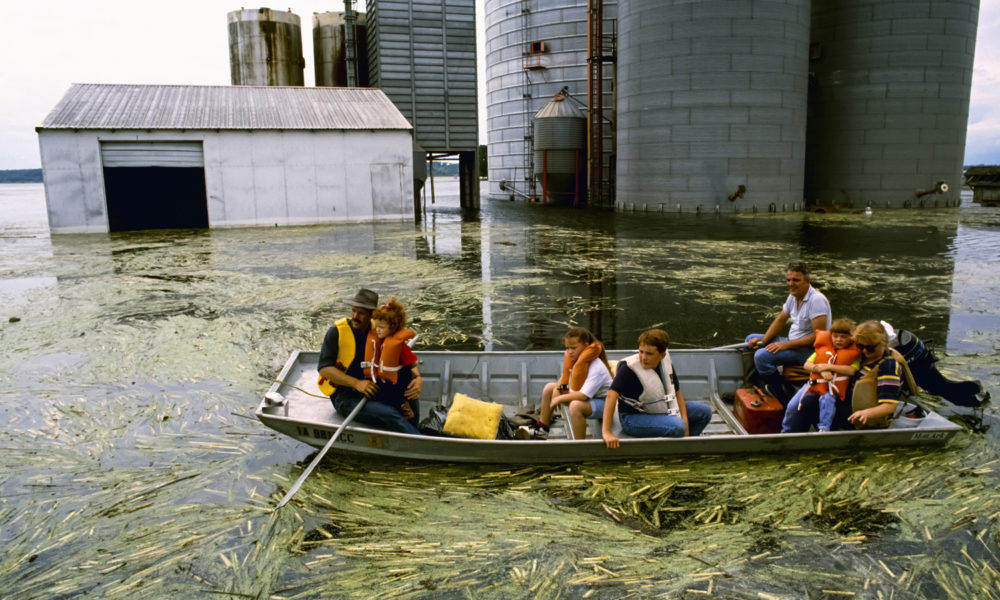Farmers in the Midwest are already feeling the effects of climate change. For example, in 2019 some areas saw between 200-600 percent the historical normal amount of precipitation. This extreme precipitation and historic flooding in the region was the primary reason that farmers across the nation were prevented from planting nearly 20 million acres of insurable crops, setting a new record.
I spoke with UCS Science Network Member, Dr. Ursula Melissa Ruiz Vera, to hear more about her research regarding the impacts of elevated CO2 combined with increases in temperature on the photosynthesis, development, and productivity of today’s most important Midwest crops, soybeans and maize.
Thanks for talking to me today, Ursula. Can you tell me a little bit about your background and research?
I’m a postdoctoral researcher at the University of Illinois in Champaign-Urbana. I focus on the physiological responses of plants to different environmental conditions, including the increase of temperature, and elevated CO2 concentration, which are some environmental changes related to climate change. I received my bachelor’s degree in biological science from the Universidad Nacional Agraria La Molina in Lima, Peru, and earned my doctorate in plant biology from the University of Illinois at Urbana-Champaign (UIUC). I’m interested in climate change, which, in my opinion, is currently the biggest threat facing humanity.
Agriculture is a huge industry in the Midwest region. Can you talk about the importance of corn and soybean crops specifically?
The “Corn Belt” stretches across much of the Midwest, including large parts of Indiana, Illinois, Iowa, Missouri, Nebraska and Kansas. For a few months of the year the corn belt is the most productive area in the world, more so than the Amazon. The Midwest region is important to the U.S. agricultural economy, since we are a major player in the world corn trade market, with between 10 and 20 percent of the corn crop being exported to other countries. Iowa and Illinois are the two top corn producing states, producing one-third of the U.S. crop, used primarily for fuel and livestock feed.
Climate change poses a considerable threat to the Midwest Region, and these valuable crops.
What has your research found regarding the effects of increased CO2 combined with increases in temperature affecting photosynthesis, plant development and productivity of maize and soybean crops in the Midwest?
My PhD. research, which I did when I was a member of the Bernacchi’s laboratory from UIUC, funded by the USDA, found that these two climate change factors, rising temperature and elevated CO2 concentrations together, negatively impacted photosynthesis and productivity on both maize and soybean crops. This experiment is very important because it was the first time that the impacts of high temperature and CO2 together were evaluated and quantified in crops growing “in field” with the use of the Free Air CO2 enrichment technology and infrared heaters. Consequently, in this experiment we were able to have a better understanding about how plants will respond under climate change conditions, in comparison with previous greenhouse and enclosure experiments.
Photosynthesis rates increase until reaching an optimal temperature, but future temperatures will most likely surpass that target, according to climate change predictions. Maize is very susceptible to heat, especially during its reproductive developmental stage, which has a short length. This negatively impacts its yield, as reported in my research.
In contrast with maize, soybeans have a long reproductive period, which allows it to be more resilient to stress, maintaining adequate seed production. Additionally, soybean, a C3 plant, can take advantage of the CO2 fertilization and produce more yield, of course until a certain threshold temperature is achieved.
The Intergovernmental Panel on Climate Change (IPCC) stated that climate change is already affecting the Midwest through increasing temperatures, changes to precipitation patterns, and increased extreme events. Can you speak to what agriculture can do to help farmers and rural communities avoid the worst impacts and even to be part of the solution?
As I mentioned previously, corn and soybeans are critical crops to the US and global agricultural economy. A clear conclusion from my work is the critical need to improve the physiological tolerance of crops to warming conditions, if we want to at least maintain or increase productivity. It is possible that in the future, genetic techniques could help crops increase photosynthetic rates and resistance to certain environmental conditions like heat and drought. There are also other recommendations that can be followed to mitigate climate change impacts like the ones listed in the IPCC report. Diversification in the food and farm system is a key strategy to reduce risks.
On a broader scale, what can we be doing to curb the worst impacts of climate change?
We can adopt smart clean energy policies that move us toward renewable energy and away from fossil fuels. There is an urgent need to act on climate change by decarbonizing our economy, and a critical step in achieving that is passing state legislation transitioning states to 100% clean and carbon free electricity.
Thanks so much for sharing your research with us, Ursula. Your conclusions make it clear to me that we must act now to mitigate some of the worst effects of climate change by passing bold clean energy policies in the Midwest region, like the Illinois Clean Energy Jobs Act

